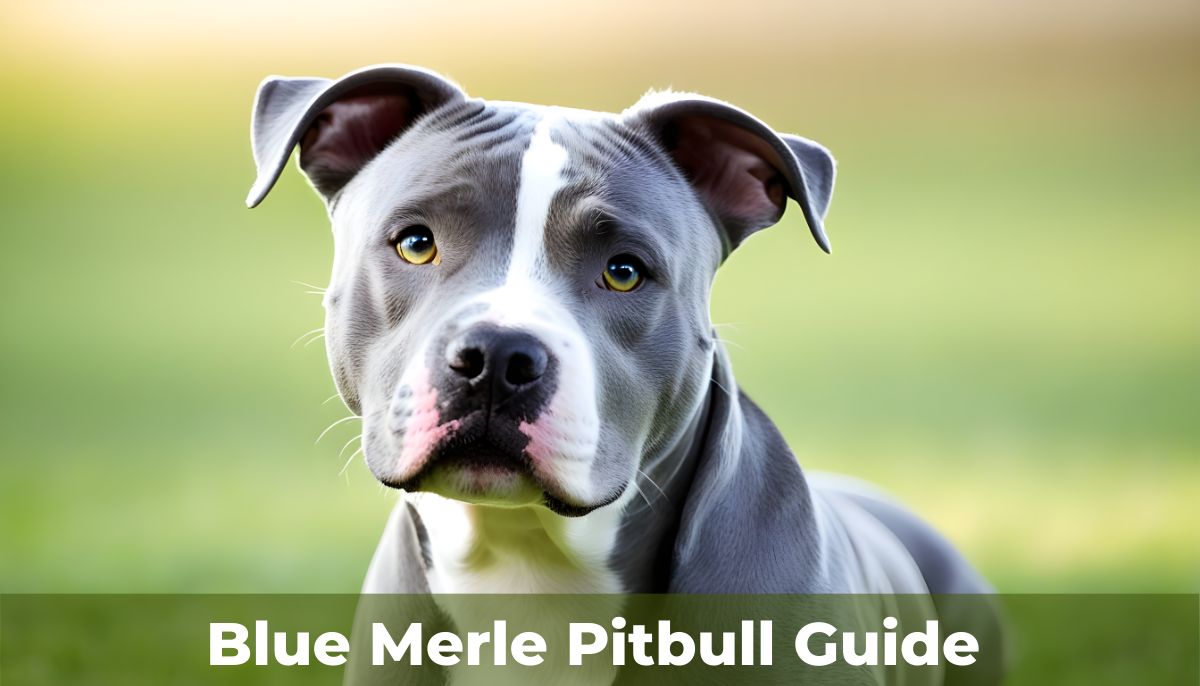The Blue Merle Pitbull is a fascinating and beautiful canine companion with a unique coat pattern. These dogs boast a striking mix of blue, gray, and black fur, creating a mesmerizing merle effect that captures attention.
Beyond their unique appearance, Merle Blue Pits are celebrated for their friendly and loyal nature. It’s important to note that they are not a separate breed but a distinctive color variation within the American Pit Bull Terrier.
In this article, we’ll delve into these Pitbulls’ origin, characteristics, care, colors and puppies, shedding light on the beautiful qualities that make them exceptional companions.
What is a Blue Merle Pitbull?
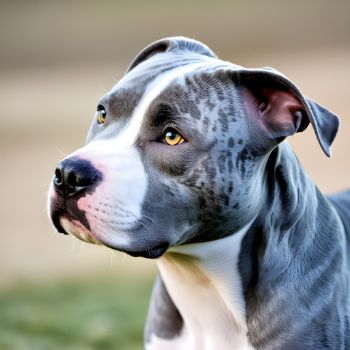
A Blue Merle Pitbull is a special kind of dog with a truly unique and beautiful coat.
Imagine a furry friend whose coat is like a beautiful painting, blending shades of blue, gray, and black mesmerizingly.
They are captivating canine companions, distinguished by their unique coat pattern.
In my experience, understanding the intricacies of this distinctive coat requires delving into the world of merle markings and the fascinating effects of dilution.
The Blue Merle coat pattern is a genetic trait characterized by a mottled or speckled appearance, blending various shades seamlessly.
It’s not a separate breed but a striking variation within the American Pit Bull Terrier.
Variations in Blue Merle Patterns:
There are different variations in the dogs of this breed, and understanding the fascinating facts about their patterns adds depth to their unique charm.
• Merle Markings:
One aspect that adds to the allure of Merle Blue Pits is the variety in merle markings.
These can manifest as patches, streaks, or spots of different sizes and shapes, creating a truly individualized look for each dog.
This diversity in markings contributes to the overall charm of these canine companions.
• Dilution Effects:
The dilution effect is like a magic touch that makes the blues and grays in the coat more or less intense. Think of it as turning up or down the brightness on your TV.
This magic touch gives some Blue Merle Pits a gentle, soft look, while others have bold and vibrant colors. It’s the secret ingredient that makes each dog’s coat uniquely captivating.
Origins and Breeding History:
The origins and breeding history of blue Pitbulls are intertwined with the broader story of the Pitbull breed.
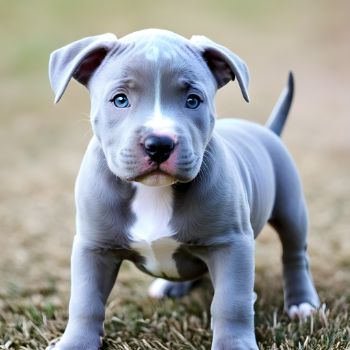
• Genetic Background:
Dogs exhibit various coat colors and patterns; multiple genes influence these traits.
The two primary pigments of coat color are eumelanin (black) and pheomelanin (red/yellow). Other genes control the distribution and intensity of these pigments.
• Merle Gene Mutation:
The distinctive merle coat pattern found in some dog breeds results from a specific gene called the “merle gene” (M locus).
This gene controls the pigment distribution in the coat, creating a mottled or speckled appearance. The merle pattern can affect eumelanin and pheomelanin, leading to various coat colors.
The merle gene mutation is associated with various health concerns, particularly when two merle-carrying dogs are bred together. This can result in a “double merle” or “lethal white” phenotype, often associated with hearing and vision issues.
• Ethical Breeding Practices:
Now, let’s touch upon the ethical side of breeding these marvelous dogs. Ethical breeding involves responsible practices that prioritize the health and well-being of the animals.
When it comes to Blue Merle Pitties, ethical breeders carefully select parent dogs, considering their health and temperament and avoiding harmful breeding practices.
This ensures that each Blue Pitbull boasts a captivating coat and enjoys a happy and healthy life.
Breeding isn’t just about creating beautiful dogs; it’s about fostering a new generation with utmost care and consideration.
Ethical practices safeguard the welfare of these fantastic animals, ensuring that their unique traits are celebrated responsibly and sustainably.
Importance of Genetic Testing:
Genetic testing serves as a safeguard, ensuring these beautiful dogs’ well-being and creating healthy and happy canine companions.
- Ensuring Health and Well-being:
- Genetic testing helps identify potential health issues in parent dogs, ensuring the overall health of the lineage.
- Minimizing Genetic Disorders:
- Breeders use genetic testing to screen for markers associated with genetic disorders, reducing the risk of passing on such conditions.
- Preserving the Merle Coat Integrity:
- Understanding the genetics of coat color and pattern aids in making decisions that maintain the unique aesthetics of these Pitbulls.
- Promoting Ethical Breeding Practices:
- Genetic testing aligns with ethical breeding, demonstrating a commitment to producing healthy and genetically diverse Blue Merle Pits.
Blue Merle Pitbull Characteristics:
They exhibit a unique blend of physical attributes that set them apart as remarkable canine companions.
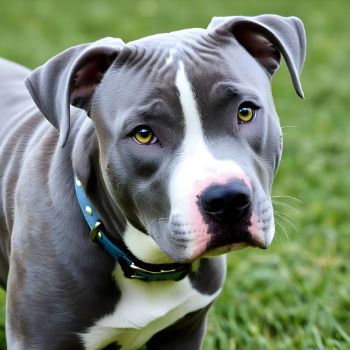
• Physical Attributes:
They are special dogs with unique features that differentiate them from other breeds.
They are solid and muscular, with robust bodies and friendly eyes.
These qualities make them both powerful and friendly, creating a good balance. It’s like they are solid but easy to approach and befriend.
• Coat Texture and Color Combinations:
The coat of these Pitbulls is a work of art in texture and color combinations.
The fur is often short, smooth, and dense, offering a sleek and shiny appearance.
The mesmerizing mix of blue, gray, and black creates a stunning pattern that varies from dog to dog, making each Merle Blue Pitbull a unique visual masterpiece.
• Care Tips for the Blue Merle Coat:
Caring for the exquisite Blue Merle coat requires attention to detail and a commitment to the dog’s well-being. Here are specific tips to ensure the health and vibrancy of the coat:
• Regular Brushing:
Regularly brushing the coat removes loose hairs, prevents matting, and promotes a shiny appearance.
• Bathing Routine:
Bathe the Pitbull as needed, using a gentle dog shampoo to maintain the coat’s cleanliness without stripping its natural oils.
• Balanced Diet:
Provide a balanced and nutritious diet to support healthy skin and coat. It is important to consult a veterinarian to determine the best food for your Blue Merle’s specific needs.
• Hydration:
Ensure ample hydration; water intake contributes to coat health and overall well-being.
• Regular Vet Check-ups:
Schedule regular veterinary check-ups to promptly address potential health issues, maintaining the coat’s luster.
• Recognizing Healthy Coat Signs:
A healthy Blue Merle coat should be:
- Smooth and shiny: The coat should not be dull or matted.
- Free of dandruff: Dandruff is a sign of dry skin, which several factors, including poor nutrition, allergies, or parasites, can cause.
- Free of odor: The coat should not have a strong odor.
- Free of irritation or redness: The skin should not be red or irritated.
• Size and Build:
They are medium-sized dogs. Males weigh between 50-65 pounds and stand 18-21 inches tall at the shoulder.Females generally are slightly smaller, weighing between 35 and 50 pounds and standing 17 to 20 inches tall at the shoulder.
• Growth Stages
These dogs are considered fully grown by around 18 months of age.They will continue to gain muscle weight until they are about 2 years old.
Here is a general overview of the growth stages:
- Newborn to 8 weeks: Puppies will grow rapidly during this time, gaining about 1 pound per week. They will also start developing their motor skills, play, and explore their surroundings.
- 8 weeks to 6 months: Puppies will continue to grow rapidly during this time, but their growth rate will slow down. They will also become more active and social and they will begin to learn basic commands.
- 6 months to 18 months: Puppies will continue to grow and mature. They will also start to reach their adult size and weight.
- 18 months to 2 years: Puppies will continue to fill out and gain muscle weight. They will also become more mature and confident.
• Ideal Body Condition:
Blue Merle Pits should be lean and muscular, with a visible waistline. Their ribs should be easy to feel, but they should not be visible. Their abdomen should be tucked up, and their chest should be broad and deep.
Here is a chart of ideal body condition scores for dogs:
| Body Condition Score | Description |
|---|---|
| 1 | Very thin: Bones are visible, and there is no palpable fat. |
| 2 | Thin: The ribs are easily felt, and there is a slight tuck to the abdomen. |
| 3 | Ideal: The ribs can be felt with light pressure and have a distinct waistline. |
| 4 | Slightly overweight: The ribs can be felt with moderate pressure, and there is a slight bulge in the abdomen. |
| 5 | Overweight: The ribs are difficult to feel, and the abdomen has a pronounced bulge. |
| 6 | Obese: The ribs are not felt, and the abdomen has a prominent bulge. |
Caring for Blue Merle Pitbulls:
It is essential to care for your pittie friend, and I am sharing with you some tips about their diet that are based on the experiences of blue Staffie owners.
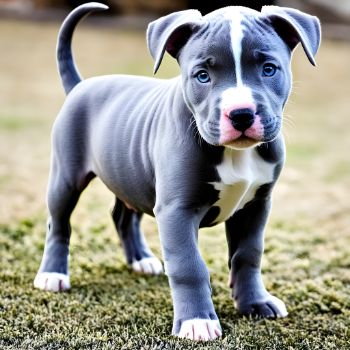
• Diet and Nutrition:
It is essential to provide our pets with a well-balanced and nutritious diet to maintain their overall health and happiness…
Regarding Blue Merle, providing the proper nutrients ensures their health and vitality.
• Nutritional Requirements:
Understanding the nutritional requirements of Merle Pitbulls is like crafting a recipe for a healthy and happy life.
These dogs benefit from a balanced diet that includes high-quality protein for muscle strength, healthy fats for a shiny coat, and carbohydrates for energy. It’s like giving them a well-rounded meal to thrive.
• Feeding Schedule:
The best feeding schedule for your Pitbull will depend on their age and activity level. Puppies should be fed 3-4 meals per day, while adult dogs can be fed 2 meals per day.
Here is a suggested feeding schedule for your dog:
• Puppies (8 weeks to 6 months)
- Breakfast: 7:00 AM
- Lunch: 12:00 PM
- Dinner: 5:00 PM
- Bedtime snack: 8:00 PM
• Adult dogs (6 months to 2 years)
- Breakfast: 7:00 AM
- Dinner: 5:00 PM
• Meal Timing:
It is essential to feed your dog at consistent times each day. This will help to regulate their digestion and prevent them from becoming hungry or overeating.
It is also important to avoid feeding your dog right before or after exercise, as this can cause digestive upset.
Exercise Needs:
They are energetic dogs that require regular exercise to stay physically and mentally fit. Failure to provide them with adequate training can lead to boredom, destructive behavior, and obesity.
• Physical Activity Recommendations:
The amount of exercise your Merle Pitbull needs will depend on age, energy level, and overall health. However, they generally need at least 1-2 hours of exercise per day. This can be divided into two or three sessions: a morning walk, an afternoon play session, and an evening walk.
• Mental Stimulation:
These dogs also need mental stimulation to stay healthy and happy. Mental stimulation can help to prevent boredom, reduce anxiety, and improve cognitive function.
• Enrichment Activities:
Introducing enrichment activities is like giving them puzzles to solve. Kong toys with treats inside or puzzle feeders engage their minds, preventing boredom and destructive behaviors.
It’s like a mental workout, giving them the stimulation they need to thrive.
Grooming Tips:
These dogs have short, smooth coats that require minimal grooming. However, it is still important to brush them regularly to remove loose hair and prevent mats.
• Frequency:
Bathe your Blue Merle once every 6 to 8 weeks, or more often if they get dirty. Avoid using human shampoo, as it can strip away the natural oils from your dog’s coat.
• Seasonal Considerations:
Just as we adjust our routines with the seasons, grooming needs to change. During hotter months, more frequent brushing helps remove and cool loose fur. In colder weather, a bit less brushing helps retain their natural insulation.
Health Considerations:
These dogs, like any breed, may encounter specific health considerations.
Common Health Issues
Here are the health matters that you need to consider about these dogs.
• Deafness and blindness:
The merle gene can interfere with the development of the eyes and ears, leading to deafness and blindness. These problems are more common in dogs with double-merle patterns but can also occur in dogs with single-merle patterns.
• Overly sensitive skin:
Dogs with merle patterns may be more sensitive to the sun and other environmental factors. This can lead to skin irritation and allergies.
• Altered pigmentation:
The merle gene can also cause changes in the nose, eyes, and lips pigmentation. This can lead to a condition called “blue eye” or “heterochromia,” in which the dog has two different colored eyes.
Is a blue merle pitbull rare?
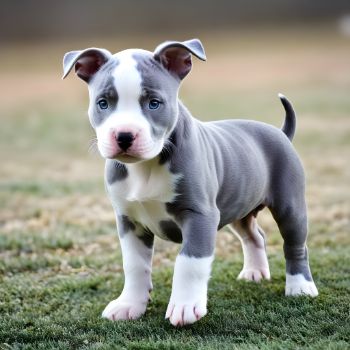
Yes, blue merle pit bulls are considered rare. The merle gene that produces the distinctive blue merle coat pattern is recessive, meaning that it must be inherited from both parents for a dog to express it.
As a result, only a tiny percentage of pit bulls are born with the merle gene.
In addition, the Merle gene can cause specific health problems, particularly in dogs that inherit two copies of the gene.
This has led some breeders to refrain from breeding merle pits altogether, reducing their numbers.
My personal experience aligns with that: while not every litter produces a Blue Merle, these unique and beautiful dogs can be found through responsible breeding practices.
As a result of these factors, blue merle pit bulls are considered to be a rare breed. They are often in high demand, and their price can reflect their rarity.
How do you create a blue Merle Pitbull?
Breeding blue merle pit bulls requires careful consideration and planning to ensure the health and well-being of the puppies.
• Select Healthy Parent Dogs:
Choose healthy pitbulls with good temperaments and no known genetic health issues. Ideally, one parent should have the merle gene (either single merle or double merle), and the other should not have the merle gene.
My experience underscores the importance of selecting parent dogs with care, considering factors like temperament and overall health.
• Genetic Testing:
Test both parent dogs before breeding to determine their merle gene status. Avoid breeding double merle pits.
My personal commitment aligns with responsible breeding practices, where the focus is not solely on coat color but on producing well-rounded, vibrant, and healthy Blue Merle Pitbulls.
FAQs
Can a Blue Merle Pitbull have non-merle puppies?
Yes, even if both parents are merle, having non-merle puppies is possible. The merle gene doesn’t guarantee the same coat pattern in every offspring.
Are Blue Merle Pitbull puppies more expensive?
Prices can vary, but coat color should not significantly impact the cost. Responsible breeders focus on overall health and quality, not just the color of the coat.
Conclusion
In wrapping up our exploration, Blue Merle Pitbulls emerge as distinctive and loving companions.
From their captivating coat patterns to their specific care needs, understanding and embracing their uniqueness is critical.
We ensure a fulfilling and joyful journey with these remarkable dogs by incorporating responsible ownership practices, including proper nutrition, regular exercise, and attentive grooming.

